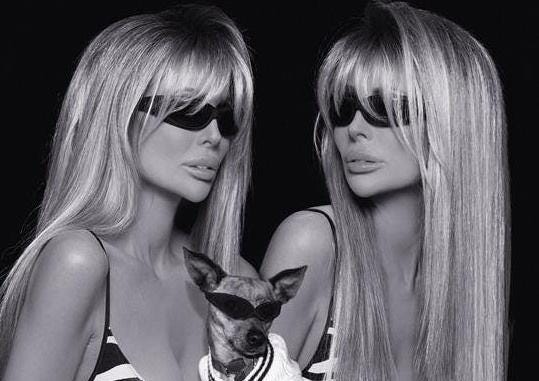Actor Eric Roberts Talks Animal Rescue from Russian Brown Bears to Backyard Bees
By Jordan Schaul | National Geographic | November 29, 2012
Contributing Editor Dr. Jordan Schaul and celebrity animal advocates the Barbi Twins interview actor Eric Roberts about his animal rescue work and his family’s love for the animal kingdom.
Eric Roberts is a Golden Globe and Academy Award-nominated actor with 100 film and television performances. Robert’s debut on screen was playing the original Ted Bancroft on the NBC daytime soap opera Another World back in 1977. He is the father of actress Emma Roberts and older brother of actresses Julia Roberts and Lisa Roberts Gillan.
The vegan animal activist and environmentalist has been an animal lover all his life. He’s rescued many companion animals from dogs and cats to horses and a bear. Yes, he and his wife Eliza demonstrated great compassion for a brown bear in need while traveling in Russia. The bear, named “Stepan” was confined to a small cage as a part of a roadside attraction in a small town. Through the Roberts’ efforts and determination, the bear was relocated to the Rostov Zoo (600 miles south of Moscow) where plans were being made to pair Stepan with a companion. Stepan has been renamed “Eric” after the famed actor who saved him.
I have a great appreciation for the plight of all 8 species of bears on this planet. Aside from the fact that the majority of bear species are threatened or endangered, a great many suffer at the hands of humans both in developed and developing nations. I was most impressed with the couple’s efforts to help this bear.
Interview:
Barbi Twins: We have run into you at so many animal fundraisers and charity events and have been involved together in emergency rescue work, including some efforts in which we have witnessed Eliza volunteer hands-on to help animals in need. You help in a number of ways to support animal rescue and advocacy. Which organizations do you and your wife support and promote?
Eric: We really feel all these organizations make such a difference, we wish everyone could support all of them! We work largely with Precious Paws, but also Carrie Ann Inaba’s foundation, Best Friends, Animal Alliance, 600million.org, anything Dennis Erdman does (usually around horses), and the same with Ellen Lavinthal, and Cat Connection…. Also, anything Michael Bell and our mutual friend Bobby are involved in… And feel free to fill in any we might be leaving out!
Barbi Twins: Do you think that the bond between you and Eliza has been strengthened through the animal charity and animal causes that you have been involved with? What was the first “team” rescue effort you and Eliza participated in together?
Eric: [Yes, of course!] Let’s see… Initially, our rescue work was with children through www.naturalchild.org. The bear was one of our early joint rescues. But with Keaton Simons and Morgan Simons—Eliza’s kids—we followed their lead. They have always done a lot of ‘personal’ rescue. Dogs who were the least likely to be adopted out of very overpopulated animals shelters, dogs thrown from cars, feral cats… One of my earliest images of Eliza was of her rescuing bees out of a swimming pool at an Emmys party.
Barbi Twins: There has been a lot of criticism of the way animals are treated in film. Has there ever been a time while you were filming that you had to intervene or step in because of probable animal abuse or cruelty?
Eric: The treatment of animals in films has changed very significantly for the better, and continues to do so. We are very, very sensitive though, so everything from the goats on THE ODYSSEY to the primates we’ve worked with on several occasions to the animals on LESS THAN PERFECT to the horses in PURGATORY… We really want to see respect from [the animal handlers] toward these precious, amazing animals. We don’t want the animals working in overly hot weather or under any kind of pressure, or to go without treats whenever they want them!
Barbi Twins: There are more pet owners than parents. How many animals reside as “family members,” in your home, and which ones are rescued or fostered?
Eric: You mean in general, or [in our case]? We have nearly lost count…Between all the kids and our extended family and us, we are outnumbered, and we love it!
Barbi Twins: Celebrities get to use their platform to convey appropriate messages regarding animal welfare, as Bob Barker did at the end of his show, insisting on spaying and neutering pets. If there was one good message you could send out concerning animals, what would it be?
Eric: Always check your car, your clothes dryer, and any small spaces to be sure your animals are safely out before you close the door! No animals should be left in cars, even with windows cracked, if the temperature outside is over 65 degrees. No angry outbursts in front of animals, even if not directed at them… They will be traumatized.
Barbi Twins: The dog and cat rescue organization you are involved with is Precious Paws. Can you tell the readers about the organization?
Eric: Precious Paws is a dog and cat rescue organization based in the Los Angeles area. This group was founded and run by a woman named Georgyne LaLone, who used to be my wife, Eliza’s casting assistant. She has worked in the entertainment industry in various capacities for thirty years, including production, and has worked on such shows as Cheers, Frasier, Wings, and the Dead Zon, but Georgyne’s first love and passion since childhood has been animals. While working at Paramount she got involved with a rescue organization through a friend and she has been involved with the cats on the lot for years, which eventually led to her founding Precious Paws in 2002. Georgyne wanted to be a veterinarian growing up, but since she ended up in entertainment, she has worked off and on at veterinary clinics on the side for years to learn all she could to benefit her rescue animals. There are a lot of rescue organizations in our industry and it’s great to have them. However, many of these people are on the boards in name only because they are there with a bunch of celebrities. Then you have the little hard-working ones where the people do all the things themselves. Susan Olsen (Cindy Brady, Brady Bunch) is on the board of directors of Precious Paws and she is hands-on in many capacities, she fosters, does TNR, promotes, and does fundraisers for Precious Paws. As we said before, Precious Paws is a small mom and pop group, they are hands-on, their rescues are in foster homes, they do not own a facility, they hold adoptions at a local Petco, they do TNR (Trap, Neuter, Release) of stray and feral cats to help curb the overpopulation problem and do as much as they can to help and educate the public. Georgyne has even come to our house many times to help us with our cats, she goes the extra mile to help those in need the best she can. You can find out more info about Precious Paws by going to: http://www.preciouspaws.org/
Barbi Twins: If your wife were to describe you as an animal, which animal would it be and why?
Eric: Probably a combination… Bird, gorilla, zebra, seal… But mostly, a bear!
The Barbi Twins Huffington Post Bio
ABOUT NATIONAL GEOGRAPHIC SOCIETY
The National Geographic Society is a global nonprofit organization that uses the power of science, exploration, education and storytelling to illuminate and protect the wonder of our world. Since 1888, National Geographic has pushed the boundaries of exploration, investing in bold people and transformative ideas, providing more than 14,000 grants for work across all seven continents, reaching 3 million students each year through education offerings, and engaging audiences around the globe through signature experiences, stories and content. To learn more, visit www.nationalgeographic.org or follow us on Instagram, Twitter and Facebook.
MEET THE AUTHOR
Jordan Carlton SchaulWith training in wildlife ecology, conservation medicine, and comparative psychology, Dr. Schaul's contributions to Nat Geo Voices have covered a range of environmental and social topics. He draws particular attention to the plight of imperiled species highlighting issues at the juncture or nexus of sorta situ wildlife conservation and applied animal welfare. Sorta situ conservation practices are comprised of scientific management and stewardship of animal populations ex situ (in captivity / 'in human care') and in situ (free-ranging / 'in nature'). He also has a background in behavior management and training of companion animals and captive wildlife, as well as conservation marketing and digital publicity. Jordan has shared interviews with colleagues and public figures, as well as editorial news content. In addition, he has posted narratives describing his own work, which include the following examples: • Restoration of wood bison to the Interior of Alaska (As Animal Curator at Alaska Wildlife Conservation Center and courtesy professor at the University of Alaska) • Rehabilitation of orphaned sloth bears exploited for tourists in South Asia (As executive consultant 'in-residence' at the Agra Bear Rescue Center managed by Wildlife SOS) • Censusing small wild cat (e.g. ocelot and margay) populations in the montane cloud forests of Costa Rica for popular publications with 'The Cat Whisperer' Mieshelle Nagelschneider • Evaluating the impact of ecotourism on marine mammal population stability and welfare off the coast of Mexico's Sea of Cortez (With Boston University's marine science program) Jordan was a director on boards of non-profit wildlife conservation organizations serving nations in Africa, North and South America and Southeast Asia. He is also a consultant to a human-wildlife conflict mitigation organization in the Pacific Northwest. Following animal curatorships in Alaska and California, he served as a charter board member of a zoo advocacy and outreach organization and later as its executive director. Jordan was a member of the Communication and Education Commission of the International Union for the Conservation of Nature (CEC-IUCN) and the Bear Specialist Group of the IUCN Species Survival Commission (BSG-SSC-IUCN). He has served on the advisory council of the National Wildlife Humane Society and in service to the Bear Taxon Advisory Group of the Association of Zoos and Aquariums (AZA Bear TAG). In addition, he was an ex officio member of the council of the International Association for Bear Research and Management.




